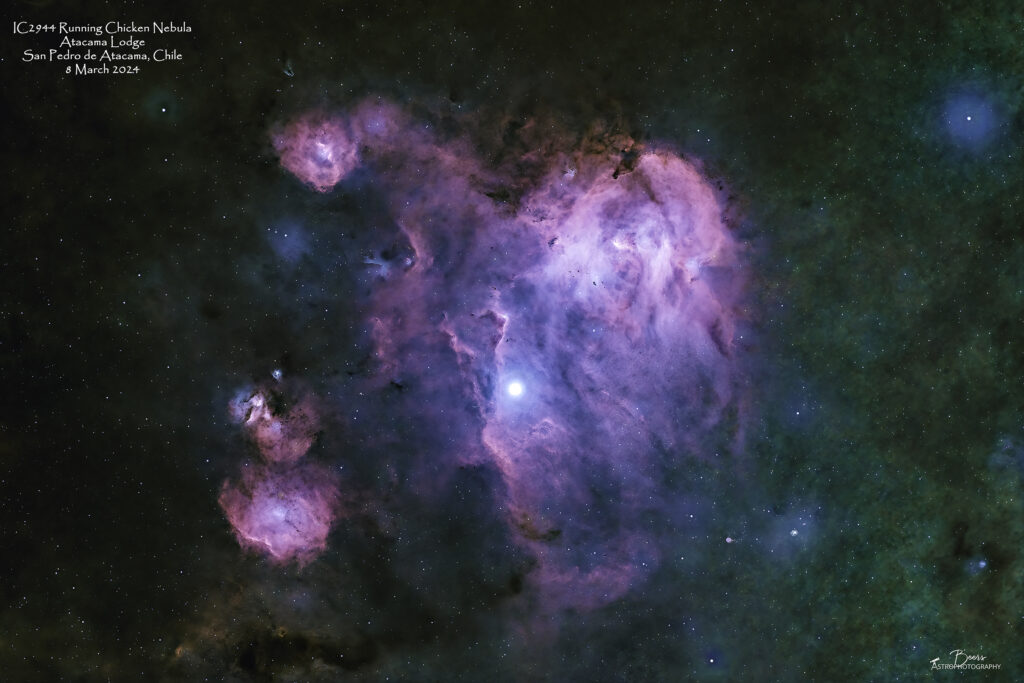
Fun facts
IC 2944, also known as the Running Chicken Nebula, the Lambda Centauri Nebula or the λ Centauri Nebula, is an open cluster with an associated emission nebula found in the constellation Centaurus, near the star λ Centauri. It features Bok globules, which are frequently a site of active star formation. However, no evidence for star formation has been found in any of the globules in IC 2944. Other designations for IC 2944 include RCW 62, G40 and G42.
The region of nebulosity visible in modern images includes both IC 2944 and IC 2948, as well as the fainter IC 2872 nearby. IC 2948 is the brightest emission and reflection nebulae towards the southeast, while IC 2944 is the cluster of stars and surrounding nebulosity stretching towards λ Centauri. IC 2944 gets the running chicken nebula name from a group of stars that resemble a running chicken. The star Lambda Centauri lies just outside IC 2944. The nebulae is 6,500 light years from earth.
Distance: 6500 light years
Apparent Magnitude: 4.5
Apparent Dimensions: 75′
Radius: 71 light years
Constellation: Centaurus
Designations: IC 2944, RCW 62, Running Chicken Nebula, Lambda Centauri Nebula, Caldwell 100
{ From https://en.wikipedia.org/wiki/IC_2944 }
Capture & Processing Notes
I imaged IC2944 on night #3 (8 March 2024) of the Atacama dessert trip between astronomical twilights and captured 100x5min exposures.
On night #3, I was still struggling with getting the park position correct for the Southern Hemisphere. I tried resetting to the current position as position #1 in the iHubo hand controller, then pointing to that position in SGP. The mount continues to park at 0, 270 degrees. So, I finally gave up and slewed to 0, 90 before starting the sequence (for the rest of the trip).
In beginning the sequence, IC2944 was low on the horizon, so the PHD2 gave an error that calibration was needed (I had selected restore calibration) – and the guiding was a bit rough to start the sequence and again after the meridian flip (causing a “BAD” marking for the four frames immediately after the flip.
During the meridian flip (based upon the issues I had on night#2 with the mount not realizing it had already done a meridian flip and asking if I wanted to pause for it, I turned off “auto meridian flip” and just woke up to do it manually in time, as I normally do anyway) again I had to rotate the mount from 0, 270 where it parked to 0, 90. Based upon the previous night’s experience, I disconnected all equipment and recycled the laptop to start anew. Same error message with PHD2 (need to turn the restore calibration back off), then things went well.
Danita and I both set up to image the Milky Way, which was low on the horizon – so we both captured the components of a Milky Way arch.
The sequence ran to completion, but there were wispy clouds that caused marking “BAD” of 8 frames that had very bloated stars. I’m surprised that the autoguider continued to work properly, as it will usually abort at the first sighting of clouds, but it did not abort the image prematurely.
Sequence Plan:
- Sequence plan: Gain: 158, Temp: -0°C, offset=30; Captured 100x5min; Total exposure time: 500 minutes, 8:20 hours. 14x5min marked bad due to clouds causing issues with autoguiding and focus. 86x5min, total time = 7:10hrs of good frames
- Captured: 8 March 2024 (8Mar2024, 2123CDT – 9Mar2024, 0541CDT);
- Shooting location: Atacama Lodge, San Pedro de Atacama, Chile
Processing summary: Captured with SGP. Stacked in APP. Star removal with Starnet++. Processed in LR/PS
Equipment
All equipment controlled by HP Probook (DSO CTRL 1) Windows 10 laptop running Sequence Generator Pro v4.3.0.1305.
- Polar alignment: QHYCCD camera (controlled by Polemaster for polar alignment)
- Imaging: (Southern Cross) Askar FRA600 on Rainbow Astro RC-135E, ZWO ASI2400MC#1 camera
- Autofocuser: ZWO EAF ( Electronic Automatic Focuser)
- Mount: Rainbow Astro RST-135E (controlled by iHubo ASCOM driver)
- Autoguiding: Orion 60mm Multi-Use Guide Scope with Orion StarShoot AutoGuider Pro Mono Astrophotography Camera (controlled by PHD2)
